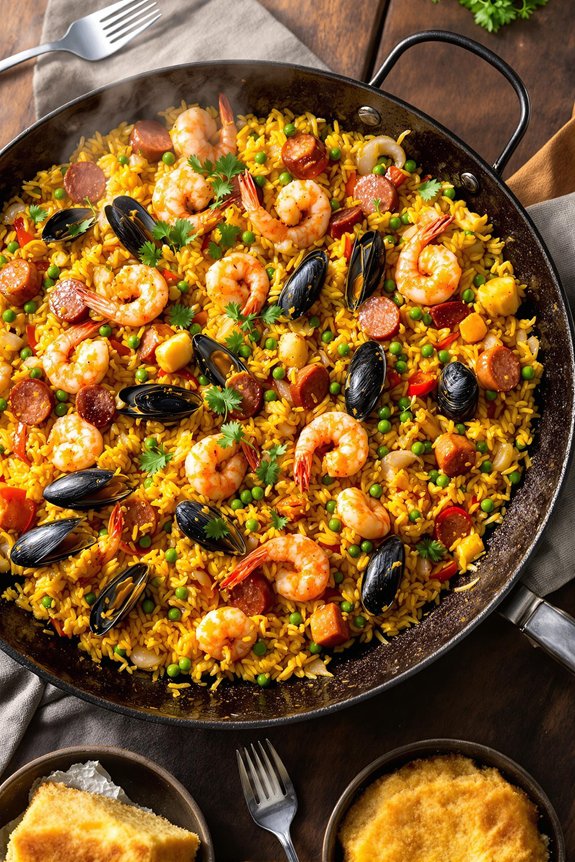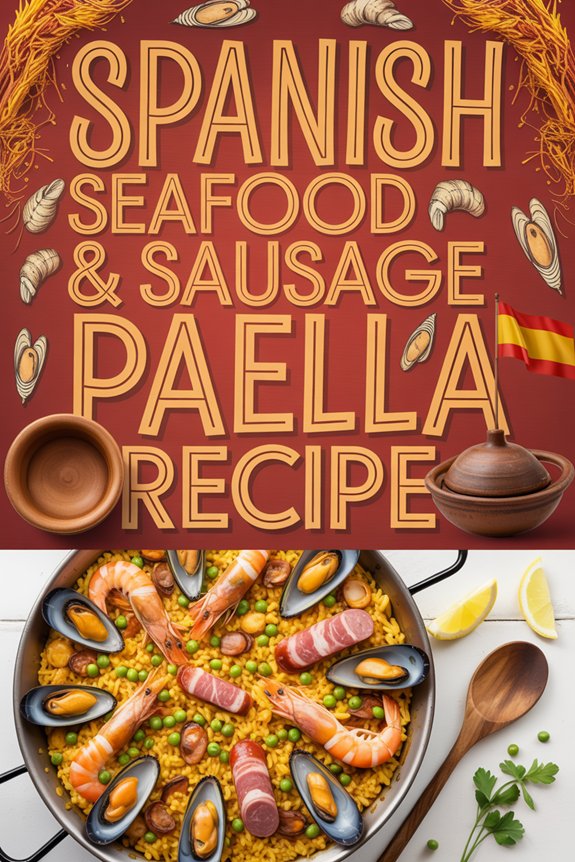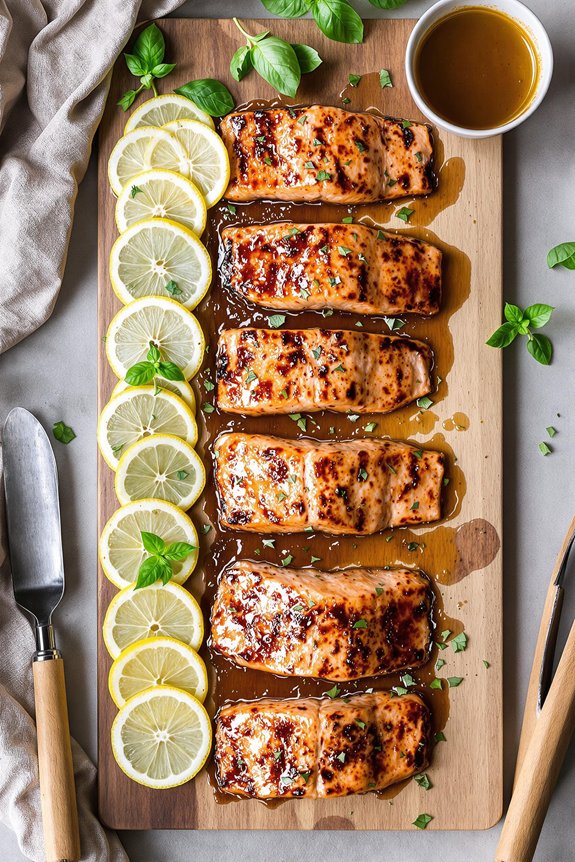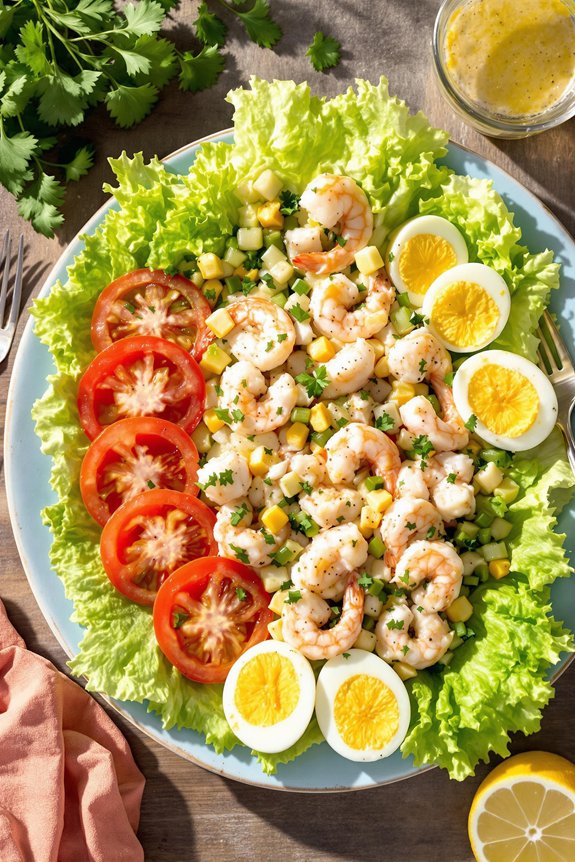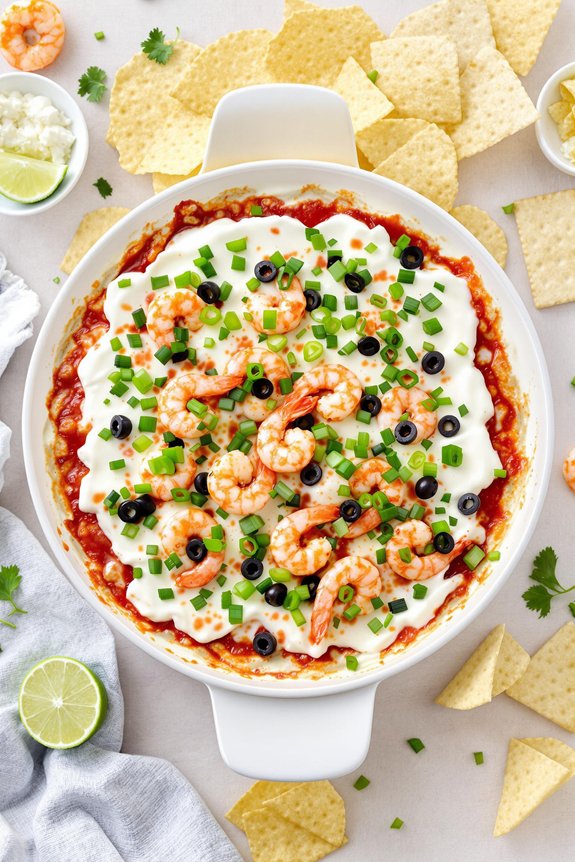Why You’ll Love this Spanish Seafood & Sausage Paella
Paella, that spectacular Spanish one-pan wonder, brings together the best of land and sea in this crowd-pleasing recipe. What’s not to love about a dish that combines succulent shrimp, tender mussels, and two types of savory sausage? The aromatic combination of saffron, paprika, and fresh garlic creates an irresistible flavor profile that’ll transport you straight to Valencia.
I adore how this paella offers incredible versatility—cook it all in one pot or use multiple pans, your choice. The vibrant colors alone make it perfect for entertaining, and those crusty rice bits at the bottom? Pure culinary gold. Serve with cornbread for a delightful fusion twist.
What Ingredients are in Spanish Seafood & Sausage Paella?
This vibrant, flavor-packed Spanish paella brings together the perfect combination of land and sea ingredients, creating a dish that’s as impressive to look at as it’s to eat. The beauty of paella lies in its harmonious blend of proteins, aromatics, and that distinctive saffron-infused rice that forms the foundation of this classic dish. Let me break down exactly what you’ll need to recreate this spectacular one-pan wonder in your own kitchen.
- 1 cup Vidalia onion, small dice
- 5 garlic cloves, minced
- 1 whole red bell pepper, diced
- 1 tablespoon olive oil
- 2 teaspoons Spanish paprika
- 1/2 pound kielbasa, sliced on the diagonal
- 1/2 pound andouille sausage, sliced
- 1 1/2 cups uncooked white rice (Basmati works well)
- 2 2/3 cups good chicken stock, plus extra as needed
- 1 pinch saffron threads
- 1 pound fresh mussels
- 1 pound medium raw shrimp, peeled & deveined
- 1 cup frozen sweet peas
- 2 tablespoons fresh parsley, chopped
When shopping for these ingredients, quality matters, especially for the seafood components. Look for mussels that are tightly closed and have a fresh, oceanic smell—nothing fishy. The saffron, while expensive, is non-negotiable for authentic paella flavor (just a pinch goes a long way). And while the recipe specifies Basmati rice, you could substitute with Bomba or Calasparra rice for an even more traditional Spanish approach. The combination of two different sausages adds complexity, but in a pinch, you could double up on one type if that’s what’s available to you.
How to Make this Spanish Seafood & Sausage Paella
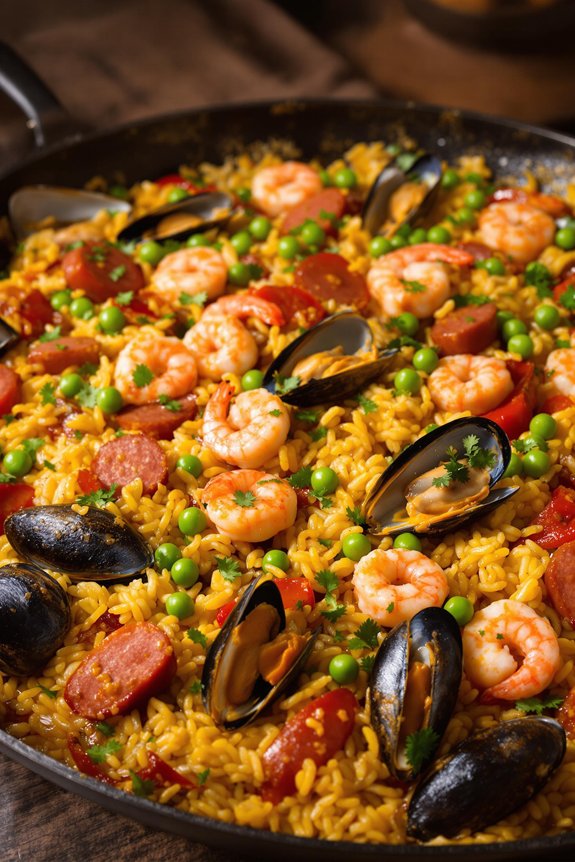
Begin your paella journey by sautéing 1 cup of diced Vidalia onion, 5 minced garlic cloves, and 1 whole diced red bell pepper with 2 teaspoons of Spanish paprika in 1 tablespoon of olive oil. This aromatic base is where all the magic starts—those sweet onions and fragrant garlic creating the foundation for what’s to come.
While the recipe notes you can use multiple pans or just one big pot, I’m firmly in the fewer-dishes-to-wash camp. In the same pot, brown both your 1/2 pound of diagonal-sliced kielbasa and 1/2 pound of andouille sausage until they develop a nice caramelization, which adds incredible depth to the final dish.
Next comes the essential rice preparation. Bring 2 2/3 cups of good chicken stock to a boil with a pinch of saffron threads—those delicate red strands that turn everything a gorgeous golden color and impart that distinctive paella flavor.
Add 1 1/2 cups of uncooked Basmati rice, cover, and simmer for about 15 minutes. The rice won’t be completely done at this point, but that’s perfect because it’ll continue cooking with the seafood.
Speaking of which, add 1 pound of fresh mussels to the pot, cover, and let them steam until they open, which takes around 20 minutes. If the rice absorbs all the liquid, don’t panic—just add a bit more chicken stock as needed.
Once those beautiful mussels have opened their shells, it’s time for 1 pound of peeled and deveined raw shrimp to join the party. They’ll need about 5 minutes to turn pink and perfectly tender.
Finally, stir in 1 cup of frozen sweet peas and 2 tablespoons of chopped fresh parsley before transferring everything to a large serving bowl.
Using premium cookware will ensure even heat distribution for perfectly cooked paella without hot spots or burning.
Might I suggest some hot cornbread with butter on the side? The contrast of textures is simply divine.
Spanish Seafood & Sausage Paella Substitutions and Variations
Now that you know the basic preparation method, let’s explore how to make this paella truly your own.
Don’t have mussels? Try clams or scallops instead. The sausage can be flexible too—chorizo works beautifully for authentic Spanish flavor, or swap in chicken thighs for a lighter option.
Vegetarians might substitute mushrooms and artichoke hearts for the proteins.
Rice varieties matter—Valencia or Arborio make wonderful alternatives to Basmati.
Can’t find saffron? Turmeric gives that lovely golden color, though the flavor isn’t quite the same.
For a summer twist, I’d toss in some fresh cherry tomatoes and zucchini during the final cooking stage.
What to Serve with Spanish Seafood & Sausage Paella
Three perfect accompaniments can transform your paella from merely delicious to an unforgettable feast.
First, I can’t recommend fresh cornbread enough—that buttery, slightly sweet crumb perfectly balances the savory, saffron-infused rice. The recipe even suggests this pairing.
A crisp Spanish white wine, like Albariño, cuts through the richness of those succulent mussels and sausages. Its bright acidity refreshes your palate between bites.
Finally, consider a simple green salad dressed with sherry vinaigrette. The clean, peppery greens provide a welcome contrast to the hearty paella.
Dinner party gold, wouldn’t you agree?
Final Thoughts
While mastering paella might seem intimidating at first, this Spanish seafood and sausage version delivers restaurant-quality results with surprisingly little fuss.
The combination of savory sausage, tender seafood, and saffron-infused rice creates a dish that’s both impressive and comforting.
I love how versatile this recipe is—swap in chicken thighs if seafood isn’t your thing, or go vegetarian with extra bell peppers and artichokes.
The one non-negotiable? That gorgeous golden rice, the true star of any paella.

